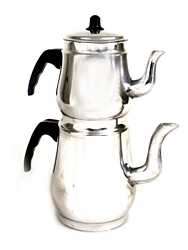Tea in Turkey

Tea (Turkish: çay pronounced [t͡ʃaj]) is popular throughout Turkey and the Turkish diaspora. Turkish tea culture also extends to Northern Cyprus and some countries in the Balkan Peninsula.
Domestic production
Most of the tea produced in Turkey is Rize tea, a terroir from Rize Province on the eastern Black Sea coast, which has a mild climate with high precipitation and fertile soil.[1] This tea is usually processed as black tea.
In 2004 Turkey produced 205,500 tonnes of tea (6.4% of the world's total tea production), which made it one of the largest tea markets in the world,[2] with 120,000 tons being consumed in Turkey, and the rest being exported.[1] Furthermore, in 2004, Turkey had the highest per capita tea consumption in the world, at 2.5 kg per person—followed by the United Kingdom (2.1 kg per person).[3]
Preparation

Turkish tea is typically prepared using two stacked kettles called "çaydanlık" specially designed for tea preparation. Water is brought to a boil in the larger lower kettle and then some of the water is used to fill the smaller kettle on top and steep (infuse) several spoons of loose tea leaves, producing a very strong tea.[1] When served, the remaining water is used to dilute the tea on an individual basis, giving each consumer the choice between strong (Turkish: koyu; literally "dark", tavşan kanı (literally: rabbit's blood) – a deep brownish red or weak (Turkish: açık; literally "light"). Tea is drunk from small glasses to enjoy it hot in addition to showing its colour, with cubes of beet sugar and without milk.
History
Tea is an important part of Turkish culture, and is the most commonly consumed hot drink, despite the country's long history of coffee consumption. Offering tea to guests is part of Turkish hospitality. Tea is most often consumed in households, shops, and by kıraathane – social gatherings of men. Despite its popularity, tea only became the beverage of choice in Turkey in the 20th century. It was initially encouraged as an alternative to coffee, which had become expensive and at times unavailable in the aftermath of World War I. Upon the loss of southeastern territories after the fall of the Ottoman Empire, coffee became an expensive import. At the urging of the founder of the republic, Atatürk, Turkish people turned more to tea as it was easily sustainable by domestic sources. Turkish tea is traditionally offered in small tulip-shaped glasses which are usually held by the rim, in order to save the drinker's fingertips from being burned, as the tea is served boiling hot.
Turkish herbal teas
In Turkey, herbal teas are generally used as herbal medication. They are mostly popular with foreign tourists with apple (elma çayı), rose hip (kuşburnu çayı), and linden flower (ıhlamur çayı) being the most consumed flavors. Sage tea (ada çayı, literally 'island tea') is most popular in the Mediterranean coastal region. In Turkey, herbal teas destined for the treatment of most ailments can be found in local herbal shops, called aktar. Dried herbal leaves, petals, shoots, etc. are sold in loose-leaf according to each customer's need and taste.
Desserts served with Turkish tea
Most often, salty or sweet biscuits called kurabiye are served with tea. Baklava is traditionally served with lemonade, not tea, as lemonade balances the cloying sweetness of baklava.
See also
References
- 1 2 3 Ergener, Rashid; Ergener, Reşit (2002). About Turkey: Geography, Economy, Politics, Religion, and Culture. Pilgrims Process, Inc. p. 41. ISBN 978-0-9710609-6-8.
- ↑ World tea production reaches new highs
- ↑ "Turkey: Second biggest tea market in the world". Euromonitor International. 13 April 2005. Archived from the original on 21 April 2013 – via Research Portals Ltd.
External links
- Turkish Tea Culture - by Katharine Branning (Video beginning in Turkish, all the rest in English)